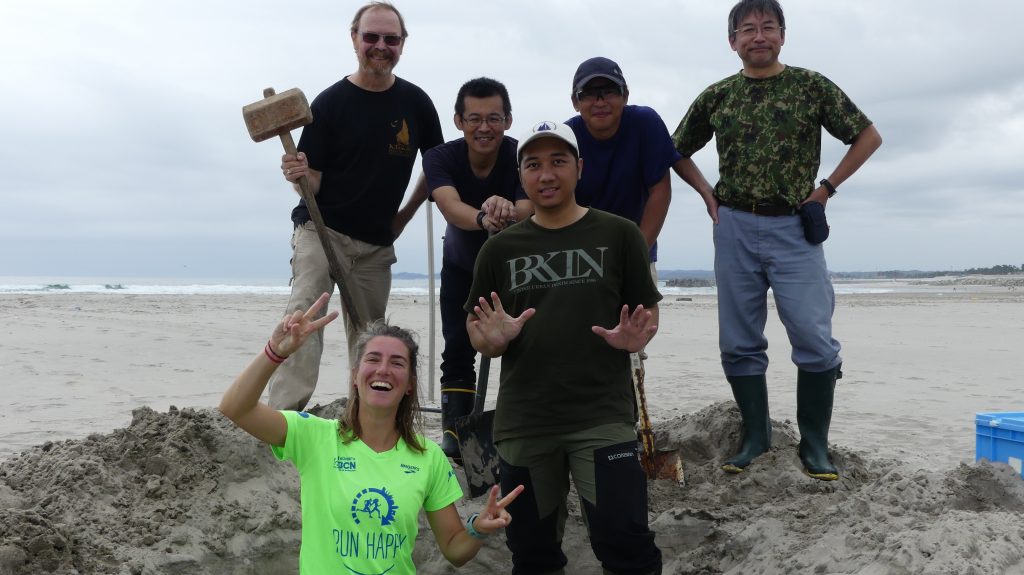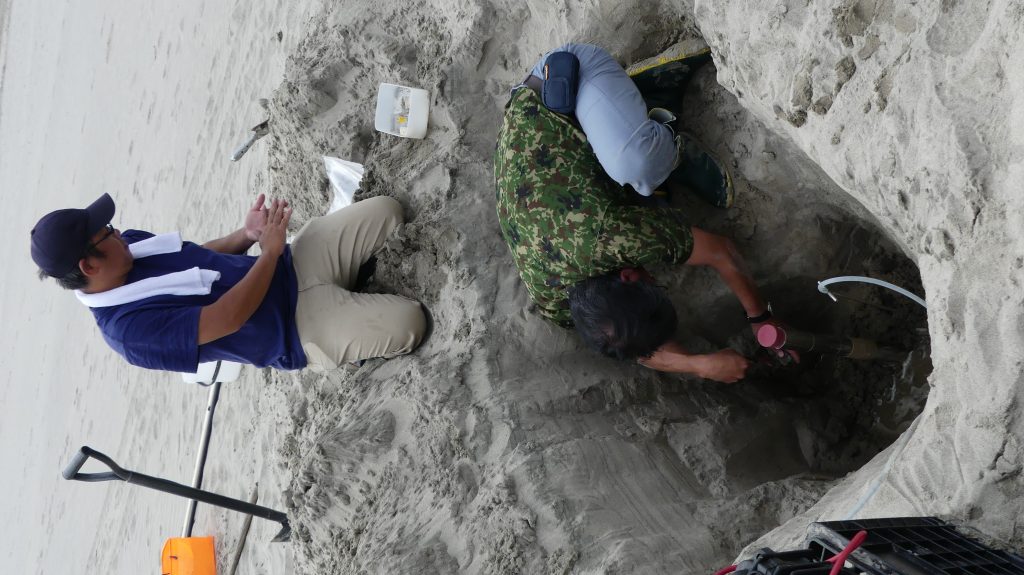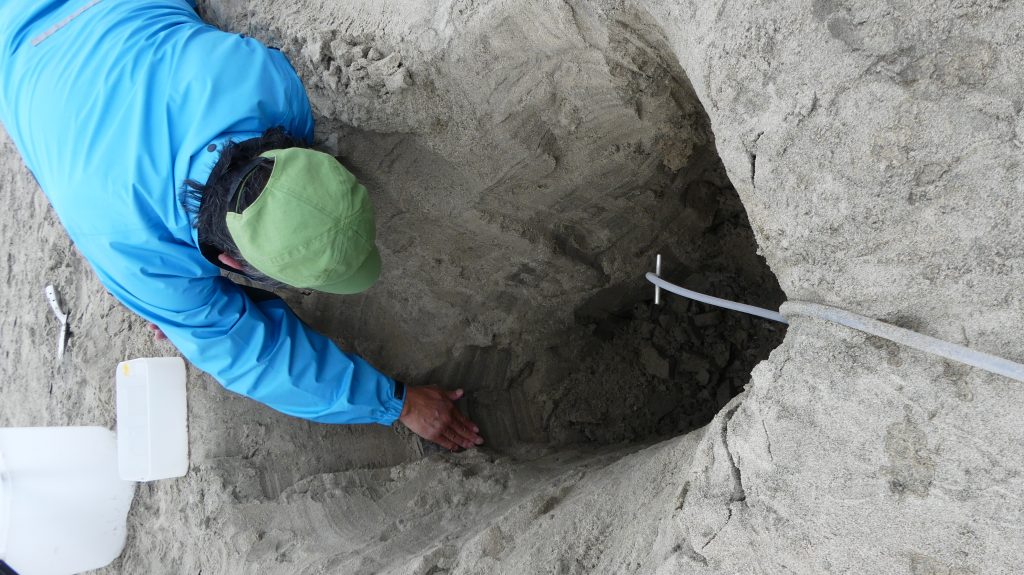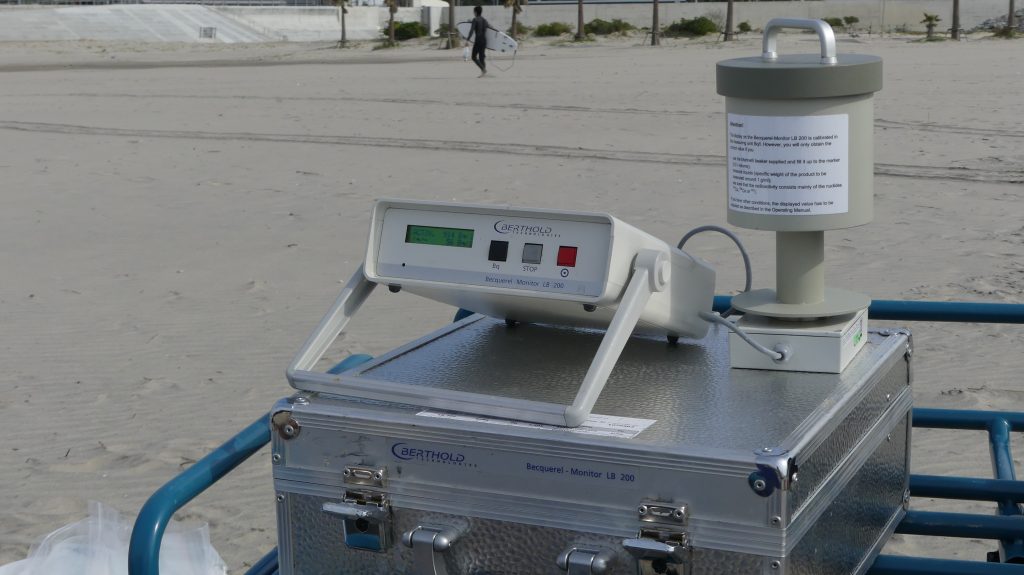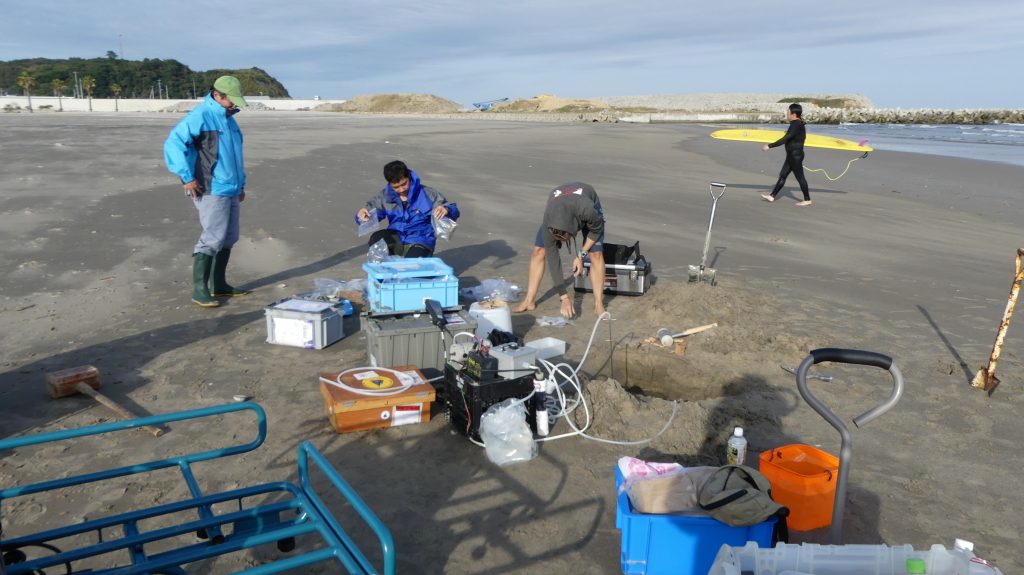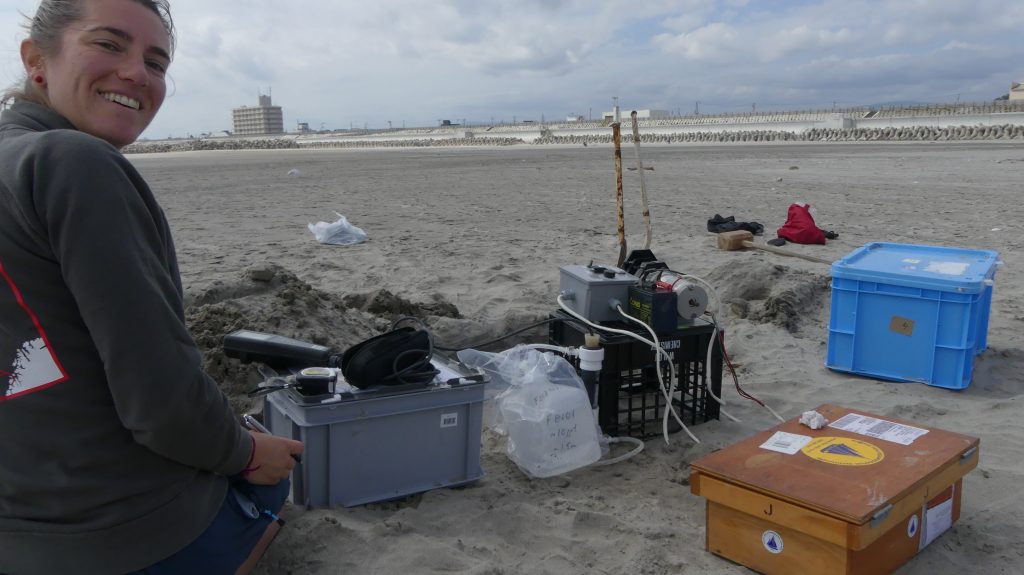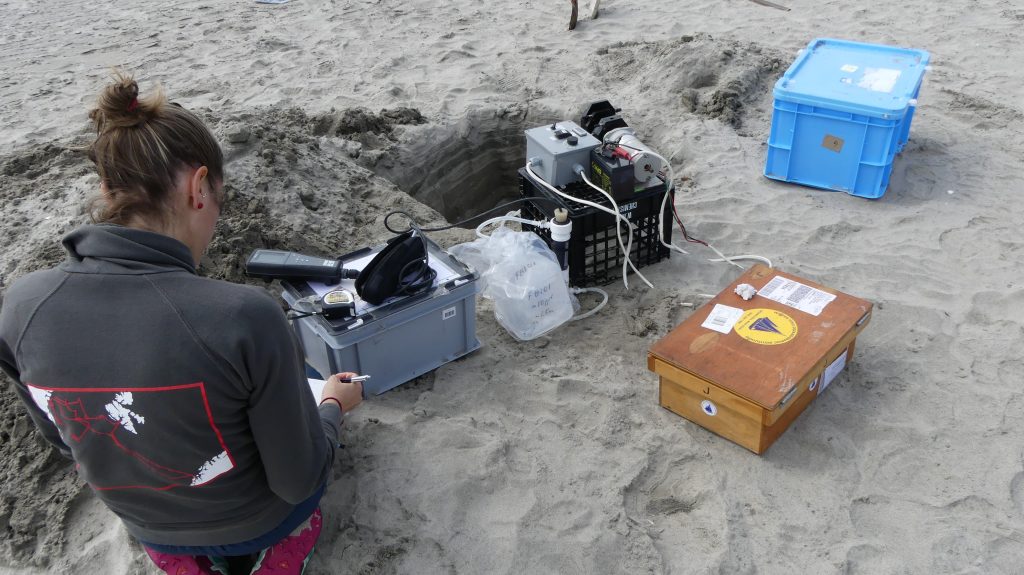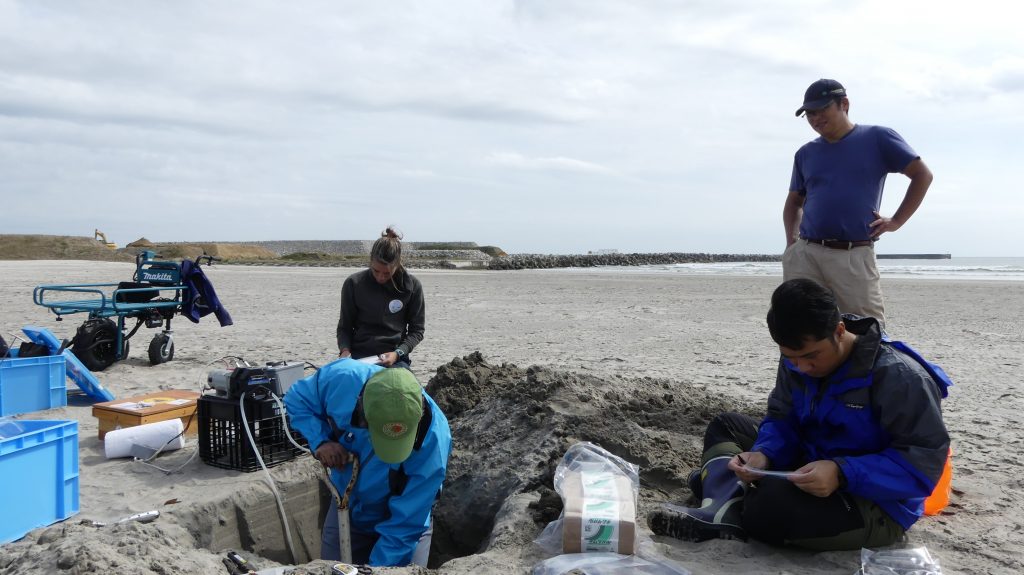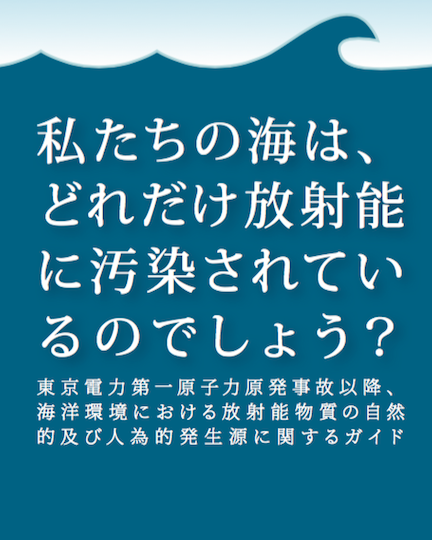This is a curated list of news reports of some of WHOI & Café Thorium's work surrounding the accident at Fukushima Dai-ichi nuclear power plant. A more extensive list may be found at OurRadioactiveOcean.org. Many news outlets report based on press releases (see above sections), so the following list has been condensed to reduce repetition.
Something in the water: controversy courts the Fukushima clean-up
June 2, 2021. Power Technology, by Heidi Vella
Japan to release Fukushima water into sea after treatment
April 12, 2021. Reuters (Asia Pacific), by Aaron Sheldrick & Yuba Obayashi
Why cleaning up Fukushima's damaged reactors will take another 30 years
March 4, 2021. Science News: Asia/Pacific, by Dennis Normile
Slow down dumping contaminated water from tsunami-crippled Fukushima Nuclear Plant, oceanographer says
August 7, 2020. Weather Channel, USA
Japan wants to dump nuclear plant's tainted water: Fishermen fear the worst
December 23, 2019. The New York Times, USA
Ken on Korean radio about releasing stored Fukushima plant water
September 23, 2019 KBS World Radio in Seoul, Korea
Fukushima: Getting rid of accumulating radioactive water (comment se débarrasser de l’eau radioactive qui s’accumule?)
September 5, 2019 Le Monde (France) (Article in French but Video section contains English).
WHOI Scientists Find New Source of Radioactive Fukushima Materials
Sunday, October 8, 2017 CapeCod.com
Scientists Discover New, Unexpected Way Fukushima Is Polluting the Ocean
Monday, October 2, 2017 The Epoch Times
Radioactive material from Fukushima disaster turns up in a surprising place
Monday, October 2, 2017 Science News
Fukushima Nuclear Waste Could Be Dumped in Pacific Ocean
Thursday, August 3, 2017 The Epoch Times
The Eric Factor: Radiation is not spreading across the Pacific
Friday, March 10, 2017 WQAD.com
Fukushima Cleanup Plans Delayed by Elevated Radiation
Monday, February 6, 2017 Laboratory Equipment
Alaska seafood is radiation free
Thursday, January 12, 2017 The Cordova Times
The Nuclear Option: How will we power the planet without wrecking the climate?
Wednesday, January 11, 2017 NOVA
Tests Find Lingering Radiation From Japan On Our Shores
Monday, December 19, 2016 Jefferson Public Radio
No risk seen from Fukushima 'fingerprint' on US West Coast
Tuesday, December 13, 2016 The Christian Science Monitor
Radiation from Japan's Fukushima nuclear disaster detected on Oregon shores
Friday, December 9, 2016 New York Daily News
Fukushima radiation has reached U.S. shores
Wednesday, December 7, 2016 Statesman Journal
US States, Agencies Work Together in Tracking Fukushima Radiation
Friday, July 1, 2016 Voice of America
Fukushima, Five Years Later
Friday, March 18, 2016 The Falmouth Enterprise
Five Years After The Fukushima Disaster, the Fish Are Proliferating
Friday, March 11, 2016 VICE
Five Years Later, Cutting Through the Fukushima Myths
Friday, March 11, 2016 Popular Mechanics
5 years after Fukushima, little radiation found in California
Thursday, March 10, 2016 San Francisco Gate
5 years later, Fukushima radiation continues to seep into the Pacific Ocean
Wednesday, March 9, 2016 PBS News Hour
Remembering Japan's 2011 Earthquake, Tsunami
Wednesday, March 9, 2016 KPMS Radio
Crippled Fukushima Reactors Are Still a Danger, 5 Years after the Accident
Tuesday, March 8, 2016 Scientific American
Containing Fukushima's radioactive water may be 9-year fight
Tuesday, March 8, 2016 CTV News
Five Years After Fukushima, Ocean Radiation Poses Little Risk to U.S.
Monday, March 7, 2016 New York Observer
The Lingering Effects of Fukushima on Fish
Monday, February 29, 2016 TIME
With Fukushima's fifth anniversary approaching, we can probably start to relax about radioactive seafood
Monday, February 29, 2016 The Washington Post
Fukushima: Five Years Later
Tuesday, February 23, 2016 Popular Science
Highest concentrations of Fukushima radiation in U.S. waters detected near San Francisco
Thursday, December 10, 2015 Mother Nature Network
High levels of Fukushima radioactivity spread off North American west coasts
Monday, December 7, 2015 Pulse Headlines
Fukushima radioactivity detected off coast of U.S., Canada
Friday, December 4, 2015 CTV News
Higher levels of Fukushima cesium detected offshore
Thursday, December 3, 2015 Phys.org
Testing finds no nuke-disaster radiation in Alaska seafood
Wednesday, December 2, 2015 Alaska Journal of Commerce
Radioactive cesium-137 from Fukushima now detected off coast of Canada
Monday, September 28, 2015 Natural News
Radiation in the Ocean
Tuesday, September 1, 2015 Huffington Post (The Blog)
Nuclear Accident: Cesium contamination persists in ocean floor near Fukushima Daiichi site
Monday, August 24, 2015 Chemical & Engineering News
How Worried Should We Be About Nuclear Fallout from Fukushima?
Saturday, August 22, 2015
Alter Net
WHOI Study Shows Fukushima Contaminated Sediment Moving Offshore
Thursday, August 20, 2015
CapeCod.com
Examining the fate of Fukushima contaminants
Tuesday, August 18, 2015 Science Daily
Fukushima Nuclear Disaster Indictment: 5 Fast Facts You Need to Know
Friday, July 31, 2015 Heavy
First evidence of Fukushima radiation reaches shores
Thursday, July 30, 2015
Cape Cod Times
Tepco May Need to Dump Fukushima Water Into Sea, UN Says
Friday, May 15, 2015 Bloomberg
DAVID SUZUKI: Citizens amplify knowledge about the natural world
Friday, May 7, 2015 David Suzuki Foundation
Is Radioactive Water Worth Worrying About?
Thursday, April 30, 2015 The New Yorker
Trace Amounts of Fukushima Radioactivity Detected Along Shoreline of British Columbia
Monday, April 27, 2015 Stories In The News
How Radioactive Is the Pacific, Really?
Friday, April 24, 2015 The Daily Beast
First evidence of Fukushima radiation reaches shores
Sunday, April 12, 2015
Cape Cod Times » Visit Website
First Fukushima radiation detected in Ucluelet waters
Friday, April 10, 2015
Peninsula News Review » Visit Website
Traces Of Radiation From 2011 Fukushima Disaster Found Off Vancouver Island
Thursday, April 9, 2015
International Business Times » Visit Website
FUKUSHIMA RADIOACTIVITY DETECTED ON NORTH AMERICAN SHORELINE
Tuesday, April 7, 2015
Eyewitness News » Visit Website
Trace Amounts of Fukushima Radiation Turn Up in Canada
Tuesday, April 7, 2015
Live Science » Visit Website
Fukushima Radiation Lands In B.C., But You Shouldn't Worry About It
Tuesday, April 7, 2015
The Huffington Post Canada » Visit Website
Traces of Radiation from Fukushima Found on British Columbia Shores
Tuesday, April 7, 2015
Environmental Protection Online » Visit Website
Radiation from Fukushima disaster newly detected off Canada's coast
Tuesday, April 7, 2015
Reuters » Visit Website
No Ocean-Borne Radiation from Fukushima Detected in Kelp from Round 3 of Sampling for Kelp Watch 2015
Tuesday, April 7, 2015
California State University - Long Beach » Visit Website
Trace amounts of Fukushima radioactivity detected along shoreline of British Columbia
Tuesday, April 7, 2015
Phys.org » Visit Website
First trace of Fukushima radioactivity detected off B.C.
Monday, April 6, 2015
CTV News Vancouver
» Visit Website
Aquarium CEO Talks Stewardship, New Fukushima Show
Thursday, March 26, 2015
Gazette Newspapers » Visit Website
Fukushima radiation helps researchers study ocean currents
Wednesday, March 11, 2015
89.3 KPCC » Visit Website
Aquarium Of The Pacific To Address Fallout Fears On Fukushima Anniversary
Wednesday, March 11, 2015
CBS Local » Visit Website
As more needy sea lions flood in, Marine Mammal Center gets help
Thursday, February 26, 2015
Laguna Beach Coastline Pilot » Visit Website
Japan's Struggle after Fukushima
Monday, February 23, 2015
Earth Times » Visit Website
Regulators: Treat, release Fukushima water to sea
Thursday, February 19, 2015
Statesman Journal » Visit Website
Stay Calm, But Radiation From Fukushima Has Crossed The Ocean To North America
Friday, January 9, 2015
Co.Exist » Visit Website
Canadian scientists track Pacific Ocean currents... using Fukushima radiation
Thursday, January 8, 2015
The Weather Network » Visit Website
Don't panic! Fukushima radiation just hit the West Coast
Wednesday, January 7, 2015
Grist » Visit Website
Tracking the Fukushima radioactivity plume across the Pacific
Wednesday, December 31, 2014
Los Angeles Times » Visit Website
Radiation from Fukushima turning up in North American waters
Tuesday, December 30, 2014
CBS News » Visit Website
Fukushima radiation: US West Coast will likely see peak by end of 2015
Monday, December 29, 2014
The Christian Science Monitor » Visit Website
Radiation from Fukushima is reaching the West Coast - but you don't need to freak out
Monday, December 29, 2014
The Washington Post » Visit Website
Citizen scientists test Pacific for Fukushima radiation
Thursday, December 11, 2014
USA Today
» Visit Website
Fukushima radiation found 400 miles west of Newport
Wednesday, December 10, 2014
Statesman Journal
» Visit Website
Radioactive Water From Japan Nears U.S.
Monday, December 8, 2014
Water Online » Visit Website
Fukushima Radioactivity Detected Off Pacific Coast; Judged Harmless
Wednesday, November 19, 2014
SitNews » Visit Website
The Environment Needs Citizen Scientists
Tuesday, November 18, 2014
Huffington Post (The Blog) » Visit Website
Fukushima radiation detected off California coast: Low levels of isotope from 2011 nuclear disaster found
Monday, November 17, 2014
Daily Mail » Visit Website
Traces of radiation from Fukushima detected by Moss Landing crew off Eureka
Monday, November 17, 2014
KSBW.com » Visit Website
California threatened by Fukushima radiation
Monday, November 17, 2014
I Know Today » Visit Website
Tiny amounts of Fukushima radiation found in California
Friday, November 14, 2014
USA Today » Visit Website
Fukushima radiation nears California coast, judged harmless
Wednesday, November 12, 2014
Science » Visit Website
Radiation From Fukushima Reaches US West Coast: What Danger Does Cesium-134 Pose?
Wednesday, November 12, 2014
International Business Times » Visit Website
Fukushima radiation is hitting the US west coast. Here's why you shouldn't freak out
Wednesday, November 12, 2014
Quartz » Visit Website
Fukushima Radiation Reaches California Coast, Contamination to Increase in Two Years?
Tuesday, November 11, 2014
TravelersToday » Visit Website
Fukushima Radioactivity Detected off California Coast
Tuesday, November 11, 2014
Fox 40 » Visit Website
Fukushima Radiation in West Coast Waters is Harmless, Say Experts
Tuesday, November 11, 2014
Nature World News » Visit Website
(Trace, harmless) Fukushima radiation has almost made it to California
Tuesday, November 11, 2014
Salon » Visit Website
Traces Of Fukushima Radioactivity Detected In West Coast Waters
Monday, November 10, 2014
Northwest Public Radio » Visit Website
Fukushima radiation detected 100 miles off California coast
Monday, November 10, 2014
CNBC » Visit Website
WHOI: Fukushima Radioactivity Detected Off West Coast
Monday, November 10, 2014
Marine Technology » Visit Website
Testing the waters for Fukushima
Thursday, September 4, 2014
Coast Reporter » Visit Website
How Radioactive Is Our Ocean?
Friday, August 29, 2014
Scientific American » Visit Website
How radioactive is the Pacific Ocean after Fukushima?
Thursday, August 28, 2014
Monterey County Weekly » Visit Website
Local group checking waters for radioactivity
Thursday, August 21, 2014
Parksville Qualicum News » Visit Website
Group: No Fukushima radiation at Oregon Coast
Wednesday, August 20, 2014
KING5.com » Visit Website
West Coast waters still safe from radioactivity, but testing continues
Wednesday, August 20, 2014
Los Angeles Times » Visit Website
Miles O'Brien returns to the site of Japan's nuclear disaster three years later
Wednesday, August 6, 2014
PBS Newshour » Visit Website
No Fukushima radiation in tests off U.S. West Coast: scientists
Tuesday, July 29, 2014
Reuters
» Visit Website
SCIENTISTS TURN TO PUBLIC TO HELP PAY FOR RESEARCH
Friday, July 11, 2014
ECN » Visit Website
Waves for Worry? Scientists weigh-in on status of radioactive waters from Fukushima reaching the California coast
Wednesday, July 9, 2014
La Jolla Light » Visit Website
Ice Wall Being Built Around Fukushima Nuclear Plant
Monday, June 9, 2014
Capital Public Radio » Visit Website
Monitoring Fukushima radiation
Sunday, May 25, 2014
Petaluma 360 » Visit Website
Tepco dumps groundwater near Fukushima into Pacific ocean
Thursday, May 22, 2014
Radio Australia » Visit Website
Five Ways To Get Involved in Science Without Going Back to School
Monday, May 19, 2014
WCAI Living Lab » Visit Website
Citizen scientist scans ocean off SLO County coast for radioactivity
Tuesday, May 6, 2014
San Luis Obispo Tribune » Visit Website
Citizen Science: Monitoring Fukushima Radiation
Thursday, April 24, 2014
Sonoma County Gazette » Visit Website
Japanese Government Seeks Approval to Dump More Radioactive Groundwater Into Ocean
Tuesday, April 15, 2014
Epoch Times » Visit Website
Japan Fukushima Radiation Reaching West Coast
Monday, April 14, 2014
Guardian Liberty Voice » Visit Website
Citizen scientists prepare to test West Coast for Fukushima radiation
Saturday, April 12, 2014
Vancouver Sun » Visit Website
Locals test ocean for radiation in Santa Cruz
Monday, April 7, 2014
KSBW » Visit Website
Scientists expect traces of ocean radiation soon
Sunday, March 16, 2014
Mendocino Beacon » Visit Website
Volunteer network tests Pacific Ocean for radiation
Sunday, March 16, 2014
The Spokesman-Review » Visit Website
Radioactive Fukushima Waters Arrive At West Coast Of America
Sunday, March 16, 2014
Forbes » Visit Website
Fukushima radiation expected at U.S. West Coast beaches soon
Saturday, March 15, 2014
Japan Times » Visit Website
Scientists expect traces of Fukushima radiation on West Coast soon
Saturday, March 15, 2014
Fox News » Visit Website
Health Fears Prompt Crowdsourced Ocean Radioactivity Tracking Site
Saturday, March 15, 2014
earthzine » Visit Website
Squelching Efforts to Measure Fukushima Meltdown
Friday, March 14, 2014
New York Times » Visit Website
Scientists: Test West Coast for Fukushima radiation
Sunday, March 9, 2014
USA Today » Visit Website
Fukushima radiation will reach California and Hawaii
Thursday, March 6, 2014
Surfer Today » Visit Website
Citizen science
Thursday, March 6, 2014
The Cordova Times » Visit Website
Fishing for data in the radioactive waters off Fukushima
Wednesday, March 5, 2014
PBS News Hour » Visit Website
Scientists track incoming Fukushima plume
Monday, March 3, 2014
Inland News Today » Visit Website
Your Radionuclides and You: Citizen Scientists Can Help Monitor Fukushima Radioactivity
Friday, February 28, 2014
PLOS blogs » Visit Website
Fukushima Radioactive Contamination May Reach West Coast Within Weeks, But Don't Worry (Yet)
Thursday, February 27, 2014
Huffington Post » Visit Website
Fukushima radiation on B.C. coast measured by crowdsourcing
Thursday, February 27, 2014
CBC » Visit Website
Nuclear Reaction Byproduct Of Fukushima Found In Canada Not A Threat: Scientists
Wednesday, February 26, 2014
Almagest » Visit Website
Radiation from Fukushima begins to reach North America
Wednesday, February 26, 2014
The State Column » Visit Website
Uncovering the secret world of the Plastisphere
Wednesday, February 26, 2014
Environmental Research Web » Visit Website
Radioactive water from Japan's Fukushima power plant reaches Canada
Wednesday, February 26, 2014
RenewablesBiz » Visit Website
Fukushima Radiation Has Reached Canadian Shores, to Hit US in April; Tepco Says Declared Radiation Levels Undercounted
Wednesday, February 26, 2014
International Business Times » Visit Website
Japan's radioactive water is about to reach North American shores
Tuesday, February 25, 2014
io9 » Visit Website
Fukushima Radiation on Its Way to California
Tuesday, February 25, 2014
Design & Trend » Visit Website
Fukushima Radiation Approaching U.S. West Coast; Monitoring Crucial, Especially For Sushi Lovers
Tuesday, February 25, 2014
Headlines & Global News » Visit Website
True: Radiation from Fukushima nuclear disaster here soon; false: It will kill you
Tuesday, February 25, 2014
Seattle Post Intelligencer » Visit Website
Radioactive water travelling from Fukushima power plant being measured by scientists
Tuesday, February 25, 2014 The Independent
Fukushima radioactivity poses little threat to California, scientists say
Tuesday, February 25, 2014
Inside Bay Area News » Visit Website
Fukushima Radiation Is Expected To Reach The US In April
Tuesday, February 25, 2014
Business Insider » Visit Website
North American scientists track incoming Fukushima plume
Tuesday, February 25, 2014
BBC News » Visit Website
Fukushima radiation in Canadian waters is not a threat, scientists say
Tuesday, February 25, 2014
Christian Science Monitor » Visit Website
Three Fukushima Radiation Studies Reflect Extensive Monitoring Efforts
Tuesday, February 25, 2014
Nature World News » Visit Website
Fukushima radiation could reach Pacific coast by April
Monday, February 24, 2014
SF Gate » Visit Website
Fukushima Radiation on its Way to California, Scientists Say it Poses No Threat
Monday, February 24, 2014
KQED Science » Visit Website
Path of Japan Tsunami Debris Predicted by Computers
Monday, February 24, 2014
Live Science » Visit Website
Fukushima radioactivity poses little threat to California, scientists say
Monday, February 24, 2014
San Jose Mercury News » Visit Website
Study: Hawaii has lower Fukushima radiation risks
Monday, February 24, 2014
Hawaii News Now » Visit Website
Radioactive Ocean Website Garners Support
Monday, February 24, 2014
Marine Link » Visit Website
The Fukushima Fallout
Wednesday, February 19, 2014
Good Times » Visit Website
Dan Haifley, Our Ocean Backyard: Eye on Fukushima radiation
Friday, February 14, 2014
Santa Cruz Sentinel » Visit Website
Citizen Science: How Radioactive is the Ocean?
Tuesday, February 11, 2014
Networx » Visit Website
Citizens to fill the Fukushima information void
Monday, February 10, 2014
The Ecologist » Visit Website
Citizen scientists can fill info gaps
Friday, February 7, 2014
Yorkton This Week » Visit Website
Searching for signs of Fukushima radiation on North Coast
Thursday, February 6, 2014
Petaluma Argus Courier » Visit Website
Radiation In Calif. Kelp? Scientists To Test West Coast Water 3 Years After Fukushima Nuclear Meltdown
Wednesday, February 5, 2014
International Business Times » Visit Website
Fukushima Wash-Up Fears in U.S. Belie Radiation Risks: Energy
Tuesday, February 4, 2014
Bloomberg » Visit Website
Citizen Scientists Can Fill Info Gaps about Fukushima Effects
Monday, February 3, 2014
Epoch Times » Visit Website
Filling in the Gaps on Fukushima Radiation and Its Effects on Fish
Thursday, January 30, 2014
EcoWatch
Is the Pacific Ocean radioactive? You can help find out
Thursday, January 30, 2014
Los Angeles Times » Visit Website
How Citizen Scientists Can Fill in Information Gaps About Fukushima
Wednesday, January 29, 2014
Huffington Post » Visit Website
How Radioactive is Our Ocean? No visible or proactive leadership role by AK DEC in monitoring radiation
Tuesday, January 28, 2014
SitNews » Visit Website
Yeah, about that Fukushima radiation...
Wednesday, January 22, 2014
Alaska Dispatch » Visit Website
Cash wanted to help monitor Fukushima ocean radioactivity
Monday, January 20, 2014
Nature » Visit Website
Crowdsourced website to help test Pacific radiation
Monday, January 20, 2014
Boston Globe » Visit Website
US residents monitor Fukushima radiation
Sunday, January 19, 2014
Aljazeera » Visit Website
Ocean Radioactivity from Fukushima Leak to be Tracked
Thursday, January 16, 2014
Live Science » Visit Website
Today on Your Call: What does the science and data tell us about the impacts of Fukushima radiation?
Thursday, January 16, 2014
KALW » Visit Website
Ocean Radioactivity from Fukushima Leak to be Tracked
Thursday, January 16, 2014
Yahoo News » Visit Website
Fukushima Radiation (Still) Poses No California Risk
Wednesday, January 15, 2014
New York Times » Visit Website
How radioactive is our ocean?
Wednesday, January 15, 2014
Phys.org » Visit Website
Crowdsourced radiation monitoring website to measure Fukushima's footprint
Wednesday, January 15, 2014
Boston.com » Visit Website
Fukushima Radiation (Still) Poses No California Risk
Wednesday, January 15, 2014
Dot Earth blog- NYT » Visit Website
Woods Hole Launches Crowd-Sourced Ocean Radiation Testing
Wednesday, January 15, 2014
Forbes » Visit Website
West Coast radiation from Fukushima disaster poses no risk, experts say
Sunday, January 12, 2014
Los Angeles Times » Visit Website
Fukushima Fear Three Years After the Tsunami Over Radiation Leaks (Video)
Thursday, January 9, 2014
ABC News » Visit Website
Inside Japan's battle to prove fish is safe after Fukushima nuclear disaster
Wednesday, December 18, 2013
CBS News » Visit Website
Fukushima: Radioactivity in the Pacific Ocean, Diluted, But Far from Harmless
Sunday, December 8, 2013
Global Research » Visit Website
Fukushima Radiation to Reach U.S. Coast at Safe Levels, NRC Says
Thursday, December 5, 2013
Bloomberg » Visit Website
Abe's stance on Fukushima water fuels skepticism
Saturday, November 2, 2013
The Columbian » Visit Website
Scientists downplay Fukushima radiation hazards
Friday, October 25, 2013
Deutsche Welle » Visit Website
For Tepco and Japan's Fukushima Daiichi nuclear plant, toxic water stymies cleanup
Tuesday, October 22, 2013
The Trentonian » Visit Website
No. 1 water woes laid to Tepco's ineptitude
Tuesday, October 22, 2013
Japan Times » Visit Website
For Tepco and Japan's Fukushima Daiichi nuclear plant, toxic water stymies cleanup
Monday, October 21, 2013
Washington Post » Visit Website
Fukushima: why next month is its biggest since 2011
Tuesday, October 15, 2013
Channel 4 News » Visit Website
Tepco's Claim Radiation Leaks Confined to Coast Called 'Silly'
Tuesday, October 8, 2013
Claims Journal » Visit Website
Scientists dismiss claims that radiation in Japan is contained
Tuesday, October 8, 2013
The Columbian » Visit Website
Tepco's claim radiation leaks confined to coast called 'silly'
Monday, October 7, 2013
The Malay Mail » Visit Website
Doubts rise on nuclear cleanup
Tuesday, September 17, 2013
Deccan Herald » Visit Website
Fukushima radioactive leaks 'impossible to stop'
Friday, September 13, 2013
World Magazine » Visit Website
Fukushima fallout not affecting U.S.-caught fish
Thursday, September 12, 2013
Tucson Sentinel » Visit Website
Japan Plans 'Ice Wall' to Block Leaking Radiation
Thursday, September 5, 2013
KQED's Forum » Visit Website
Japan: How dangerous is Fukushima's radioactive water leaks?
Thursday, September 5, 2013
First Post » Visit Website
Your Phone Is Deadlier Than Pacific Sushi
Thursday, September 5, 2013
Bloomberg » Visit Website
Scientists Say West Coast Seafood Remains Safe Despite Fukushima Leaks
Thursday, September 5, 2013
Monterey County Weekly » Visit Website
Solving The Fukushima Radioactivity Problem: Dump It All Into The Ocean
Wednesday, September 4, 2013
Forbes » Visit Website
Errors cast doubt on Japan's nuclear cleanup
Wednesday, September 4, 2013
NDTV » Visit Website
Is our seafood radioactive, or is it safe to eat?
Tuesday, September 3, 2013
Chicago Tribune » Visit Website
Radiation And Risks At Fukushima
Tuesday, September 3, 2013
WBUR's On Point » Visit Website
Scientists say Fukushima danger limited -- for now
Tuesday, September 3, 2013
Stars and Stripes » Visit Website
Errors Cast Doubt on Japan's Cleanup of Nuclear Accident Site
Tuesday, September 3, 2013
New York Times » Visit Website
Hawaii Scientists Seek To Calm U.S. Fears About Fukushima Radiation
Tuesday, September 3, 2013
Huffington Post » Visit Website
Is our seafood radioactive, or is it safe to eat?
Tuesday, September 3, 2013
Los Angeles Times » Visit Website
Radioactive groundwater at Fukushima nears Pacific
Saturday, August 31, 2013
Northwest Asian Weekly » Visit Website
Fukushima Water Leaks: New Source of Health Concerns?
Friday, August 30, 2013
Live Science » Visit Website
Fukushima Water Leaks: New Source of Health Concerns?
Friday, August 30, 2013
Yahoo News » Visit Website
Are the Japanese government lying about the fallout from Fukushima?
Thursday, August 29, 2013
NewsTalk » Visit Website
Fukushima leak worse than authorities are letting on
Friday, August 23, 2013
Energy Live News » Visit Website
Latest Radioactive Leak at Fukushima: How Is It Different?
Wednesday, August 21, 2013
National Geographic » Visit Website
Fukushima's Radioactive Water Leak: What You Should Know
Wednesday, August 7, 2013
National Geographic » Visit Website
Fukushima ocean radiation panel to be live-streamed
Friday, May 3, 2013
Summit County Citizens Voice » Visit Website
The Challenges of Disaster Follow-up Research
Tuesday, April 30, 2013
Living Lab-WCAI » Visit Website
Japan fishing crippled 2 years after tsunami
Saturday, March 16, 2013
CBS News » Visit Website
Fukushima Two Years Later: Symposium - NYC - March 11-12
Wednesday, February 13, 2013
Phys.org » Visit Website
Japanese govt, TEPCO deny Fukushima radiation is tainting fish
Tuesday, November 20, 2012
Australian Broadcasting Co. (ABC News) » Visit Website
Ocean still suffering from Fukushima fallout
Thursday, November 15, 2012
Nature » Visit Website
Fukushima fish still contaminated from nuclear accident
Monday, October 29, 2012
The Hindu » Visit Website
Fukushima fish: Still off the menu
Monday, October 29, 2012
Asiancorrespondent.com » Visit Website
Fukushima fish unsafe for years
Saturday, October 27, 2012
The Age » Visit Website
Fish caught off Fukushima have high radiation levels
Saturday, October 27, 2012
Times of Malta » Visit Website
Levels of radioactive chemical found in fish off coast of Fukushima are NOT dropping
Friday, October 26, 2012
Daily Mail » Visit Website
Fish Off Japan's Coast Said to Contain Elevated Levels of Cesium
Friday, October 26, 2012
New York Times » Visit Website
Post-Fukushima, Are Japan's Fish Safe to Eat?
Friday, October 26, 2012
Huffington Post Canada » Visit Website
Radioactive levels staying high off Fukushima Daiichi in Japan
Friday, October 26, 2012
CNN » Visit Website
Japan quake-hit nuclear plant "may still be leaking radiation" into sea
Friday, October 26, 2012
Reuters US » Visit Website
Home / World / Asia-Pacific Continuous leak feared at Japan nuclear plant
Friday, October 26, 2012
China Daily » Visit Website
Radiation settles on seabed off Japan
Friday, October 26, 2012
Australian Broadcasting Co. (ABC News) » Visit Website
Fukushima Watch: The Riddle of the Radioactive Fish
Friday, October 26, 2012
Wall Street Journal » Visit Website
Fukushima fish still hot
Friday, October 26, 2012
Nature newsblog » Visit Website
Fukushima fish 'may be inedible for a decade'
Thursday, October 25, 2012
The Guardian » Visit Website
Fears Accompany Fishermen in Japanese Disaster Region
Tuesday, June 26, 2012
New York Times » Visit Website
Looking For Traces Of Fukushima In The Pacific
Wednesday, April 4, 2012
Asian Scientist Magazine » Visit Website
Fukushima Radiation Moving Across Pacific Ocean
Wednesday, April 4, 2012
Huffington Post » Visit Website
Fukushima radiation at sea studied
Wednesday, April 4, 2012
UPI.com » Visit Website
Team Releases Findings from 2011 Cruise to Measure the Impacts of Fukushima Radiation
Wednesday, April 4, 2012
EP Magazine » Visit Website
Sampling the Pacific for Signs of Fukushima
Wednesday, April 4, 2012
The Maritime Executive » Visit Website
Sampling the Pacific for Signs of Fukushima
Wednesday, April 4, 2012
Hydro International » Visit Website
Sampling the Pacific for signs of Fukushima
Tuesday, April 3, 2012
Science Codex » Visit Website
Radioactive Hotspots Found Far From Fukushima Disaster
Tuesday, April 3, 2012
International Business Times » Visit Website
Sampling the Pacific for Signs of Fukushima
Tuesday, April 3, 2012
Science Daily » Visit Website
What Fukushima accident did to the ocean
Sunday, March 11, 2012
CNN » Visit Website
Radiation detected 400 miles off Japanese coast
Monday, February 27, 2012
Foster's Daily Democrat » Visit Website
Radiation From Nuclear Plant Detected Far Off Japan's Coast
Wednesday, February 22, 2012
U.S. News & World Report » Visit Website
Cruise finds Fukushima pollution
Wednesday, February 22, 2012
BBC News » Visit Website
Nuclear Damage Control
Friday, February 10, 2012
Business Insider » Visit Website
A Tantalizing View of What Set Off Japan's Killer Quake
Friday, January 27, 2012
Science AAAS » Visit Website
Fukushima's Impact on the Ocean Analyzed
Friday, January 13, 2012
IEEE Spectrum » Visit Website
Lessons From Fukushima: How Can We Prevent Future Disasters?
Wednesday, December 14, 2011
Goodlifer blog » Visit Website
Fukushima ocean radiation could pose sleeper threat
Thursday, December 8, 2011
SmartPlanet.com » Visit Website
Researcher Assess Radioactivity Released From The Fukushima Dai-Ichi Nuclear Power Facility
Wednesday, December 7, 2011
Red Orbit » Visit Website
Fukushima's radioactive sea contamination lingers
Friday, September 30, 2011
New Scientist » Visit Website
Fukushima's Contamination Produces Some Surprises at Sea
Thursday, September 29, 2011
New York Times (blog) » Visit Website
A Foundation Acts Fast to Help Researchers Study Japan's Disaster
Sunday, June 26, 2011
The Chronicles of Philanthropy » Visit Website
Scientists on UH research ship study impact of radiation releases
Tuesday, June 14, 2011
Hawaii News Now » Visit Website
Scientists study ocean impacts of radioactive contamination from Fukushima nuclear plant
Friday, June 10, 2011
PhysOrg.com » Visit Website
Follow along with Fukushima researchers
Friday, June 10, 2011
Deep Sea News (blog) » Visit Website
So Where is Japan's Radiation Going?
Tuesday, June 7, 2011
Mother Jones » Visit Website
Scientists Study Ocean Impacts of Radioactive Contamination from Japan's Fukushima Nuclear Power Plant
Tuesday, June 7, 2011
Stony Brook University » Visit Website
Expedition to Measure Radioactive Contaminants
Monday, June 6, 2011
Hydro International » Visit Website
Scientists to study effects of nuclear crisis on ocean
Friday, June 3, 2011
The Spokesman Review » Visit Website
Scientists to Study Ocean Impacts of Japan Radiation
Friday, June 3, 2011
Honolulu Civil Beat » Visit Website
Nuclear Crisis in Japan
Friday, May 27, 2011
Center for Research on Globalization » Visit Website
Japan Earthquake Appears To Increase Quake Risk Elsewhere In The Country
Thursday, May 26, 2011
Medical News Today » Visit Website
Japan quake increased stress in some areas
Wednesday, May 25, 2011
UPI.com » Visit Website
After Japan Nuclear Power Plant Disaster: How Much Radioactivity In The Oceans?
Monday, May 23, 2011
Pollution Online » Visit Website
Radioactivity in the Oceans After Japan Nuclear Power Plant Disaster
Thursday, May 19, 2011
Kansas City infoZine » Visit Website
After Japan nuclear power plant disaster: How much radioactivity in the oceans?
Thursday, May 19, 2011
PhysOrg.com » Visit Website
After Japan Nuclear Power Plant Disaster: How Much Radioactivity in the Oceans?
Wednesday, May 18, 2011
NSF » Visit Website
The TeraGrid Community Steps Up To Help Japan In Crisis
Friday, May 6, 2011
RedOrbit » Visit Website
Japan's irradiated waters: How worried should we be?
Tuesday, April 26, 2011
CNN International » Visit Website
Japan Nuclear Plant Is Far From Stable: U.S. Report
Wednesday, April 6, 2011
Good Morning America- ABC News » Visit Website
Japanese nuclear plant dumps radioactive water into ocean
Monday, April 4, 2011
Press Herald » Visit Website
Ocean Currents, Natural Dilution Dissipate Japan's Nuclear Risk to Seafood
Tuesday, March 22, 2011
Bloomberg News » Visit Website
WHOI experts stress lessons From Japan earthquake
Monday, March 14, 2011
PhysOrg.com » Visit Website
Japan Earthquake: Doomsday? Or Just a Restless Earth?
Saturday, March 12, 2011
ABC News » Visit Website
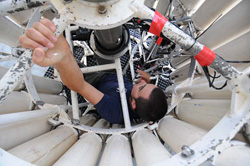
 In the time since the FDNPP accident it has come to light that there is a gap in oversight for monitoring nuclear contaminants in the ocean. While the Gordon & Betty Moore Foundation and NSF funded the initial cruise described above, no funding could be found to monitor the coasts of North America for the inevitable arrival of radionuclides from Fukushima Dai-ichi. For this reason the program Our Radioactive Ocean commenced in 2014. A crowd funded program that enlists citizens or groups to fund-raise, take a water sample at a location of their choice, and have it analyzed by Café Thorium. This program, described at OurRadioactiveOcean.org has so far collected almost 200 samples and filled a vital gap for understanding the fate and concentrations of radionuclides in the environment.
In the time since the FDNPP accident it has come to light that there is a gap in oversight for monitoring nuclear contaminants in the ocean. While the Gordon & Betty Moore Foundation and NSF funded the initial cruise described above, no funding could be found to monitor the coasts of North America for the inevitable arrival of radionuclides from Fukushima Dai-ichi. For this reason the program Our Radioactive Ocean commenced in 2014. A crowd funded program that enlists citizens or groups to fund-raise, take a water sample at a location of their choice, and have it analyzed by Café Thorium. This program, described at OurRadioactiveOcean.org has so far collected almost 200 samples and filled a vital gap for understanding the fate and concentrations of radionuclides in the environment.